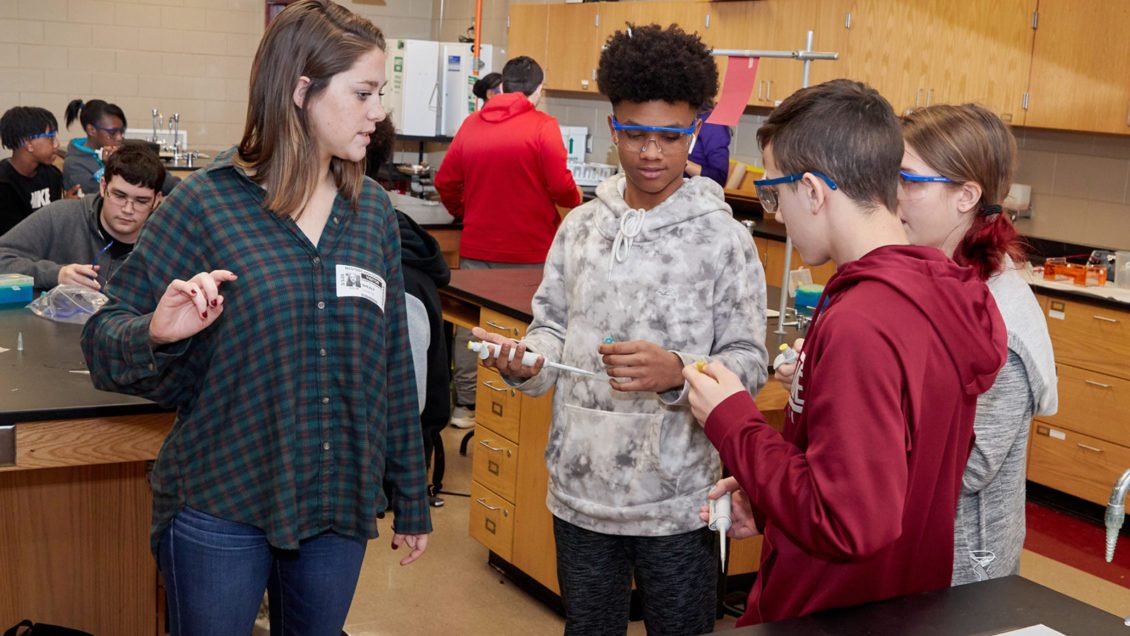CLEMSON — A crime has been committed and 120 students at Westside High School in Anderson, S.C., will use science to help solve it. Someone has stolen the Clemson Tiger mascot’s costume, but thanks to DNA evidence left at the scene, the students can use forensic science to help catch the culprit.

This was the premise of a 90-minute, hands-on activity that staff and volunteers from the Clemson University’s Life Sciences Outreach Center (CULSOC) conducted with students on Tuesday, March 3, in two of the high school’s science labs.
The day’s events were sponsored by the College of Science Women in Science Defining our Moments (WISDOM) program, which creates community and support for women pursuing science majors.
The lab activity was led by CULSOC instructors Cathy Brooks and Katherine Freeman, who gave the students a primer on DNA and genes, taught them to use micropipettes to run the four suspects’ DNA on a gel, and showed how forensics investigators use restriction fragment length polymorphism to solve real crimes.
“You did that fantastically,” sophomore Ethan Wilson said to lab partner Tyron Lomax as they high-fived each other after successfully putting DNA samples into a gel electrophoresis unit for processing.
Because it would take about two hours to analyze the DNA, the students examined the samples that CULOSC instructor Cathy Brooks ran prior to class. Donning protective goggles, they looked at the illuminated samples in a UV light box and found a match with one of the fictional suspects.
“I never did this before,” Lomax said. “I liked it a lot. It was fun doing a new thing.”
Added Wilson: “If I ever wanted to do this as a job, I’d have this little bit of experience to go on.”
“This is a really great opportunity for these students because they don’t usually get to try things like this,” Westside science teacher Taylor Staley said. “I’m excited that they can do the lab and hopefully this will open them up to how science is used,” noting that the lab is a solid introduction to the unit on biotechnology that she’ll be teaching later this semester.
Freshman Chikosi Reed was impressed with the lab session. “I learned that I have a lot more DNA in common with the people next to me than I knew before,” he said. “I also learned how to use a pipette, which might help me in biology in the future.”
During the lunch hour, the Clemson staff and volunteers met with more than 100 Westside students in the school’s commons area, where they talked about the various science fields and what the high school students should do to prepare for college.

Miss South Carolina and Clemson alumna Morgan Nichols (BS 2019, genetics) was a special guest. She encouraged the high-schoolers to consider learning and working in the fields of Science, Technology, Engineering and Math (STEM) — a message she incorporated into her Miss America pageant platform last fall.
“I never knew that I wanted to go into science until I saw a female doing science,” Nichols said. “By being here today, we’re showing the women that they can go into science or any STEM field they desire.”
At the conclusion of lunch, many of the young women signed the WISDOM wall, expressing their desire to pursue STEM fields in college.
According to CULSOC director Renee Lyons, the outreach center conducts this particular lab activity frequently for student groups that come to campus. Thanks to funding from faculty research grants that have an outreach component or foundation and corporate sponsors, she and her team are now able to take the lab to high schools, as well.
“We’ll go to high schools that can’t afford the field trip to campus,” Lyons said. “All of our labs are aligned to the S.C. Science Standards, so we support what teachers are already teaching in their classrooms. Our labs provide students and their teachers access to technology that they typically do not have access to.”
View more photos on the College of Science Facebook page.
Get in touch and we will connect you with the author or another expert.
Or email us at news@clemson.edu

